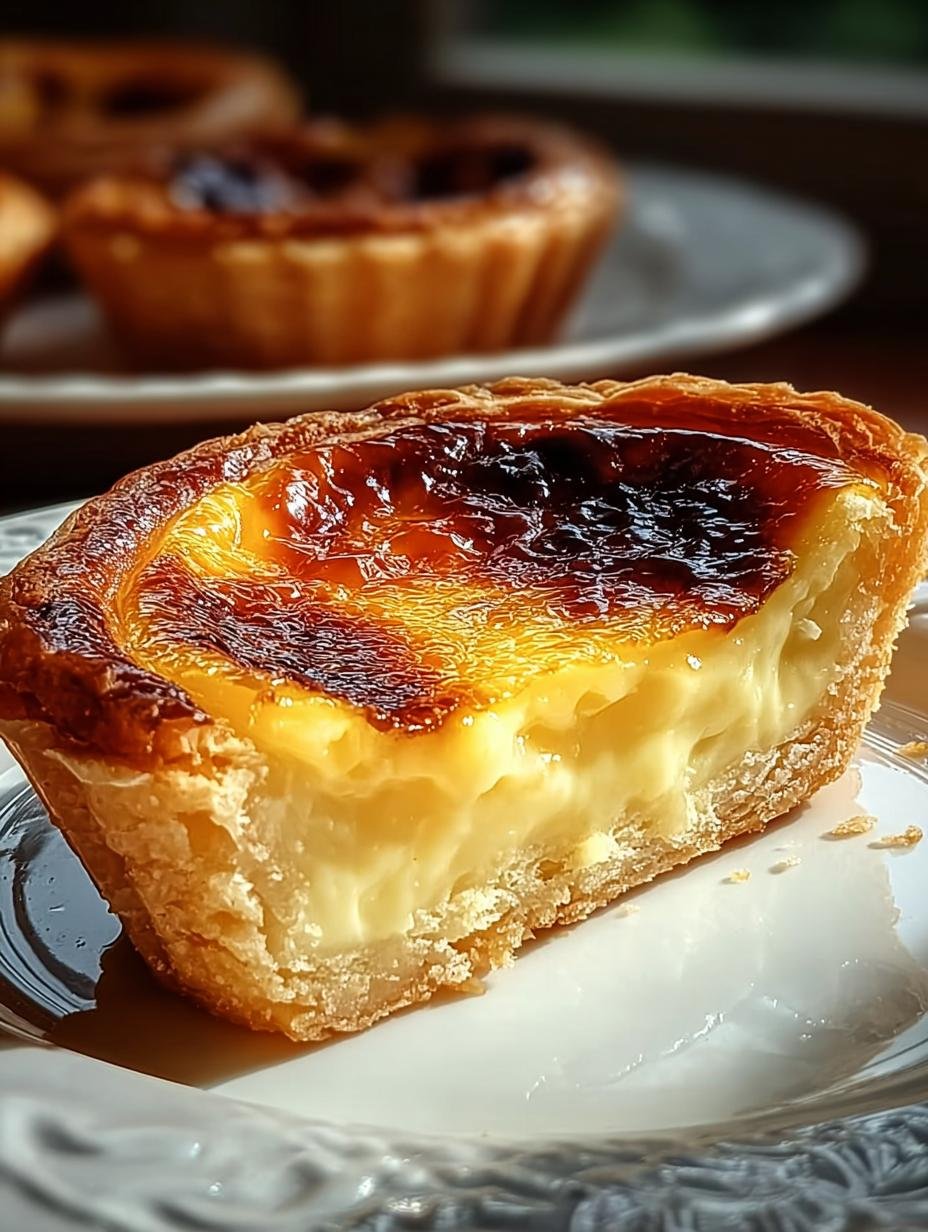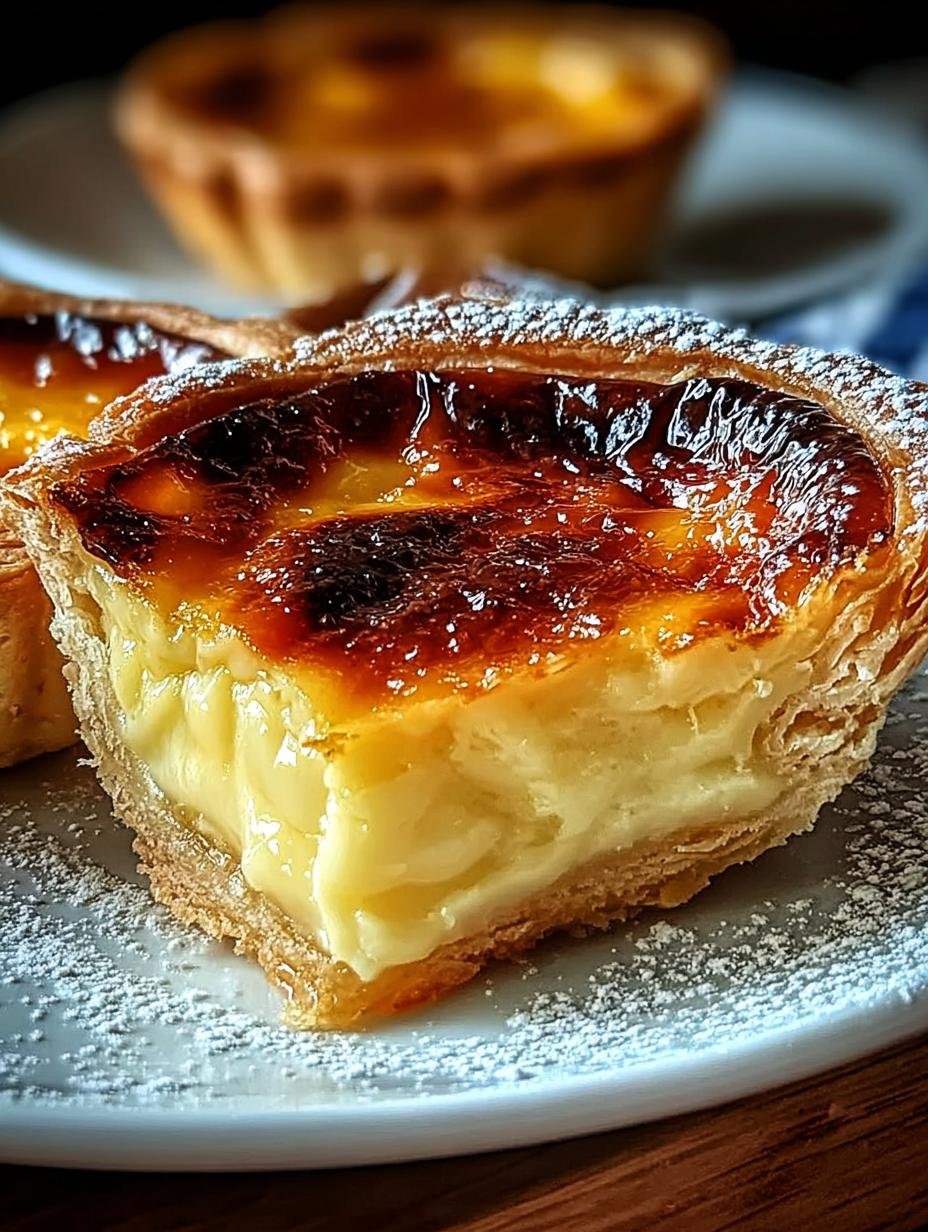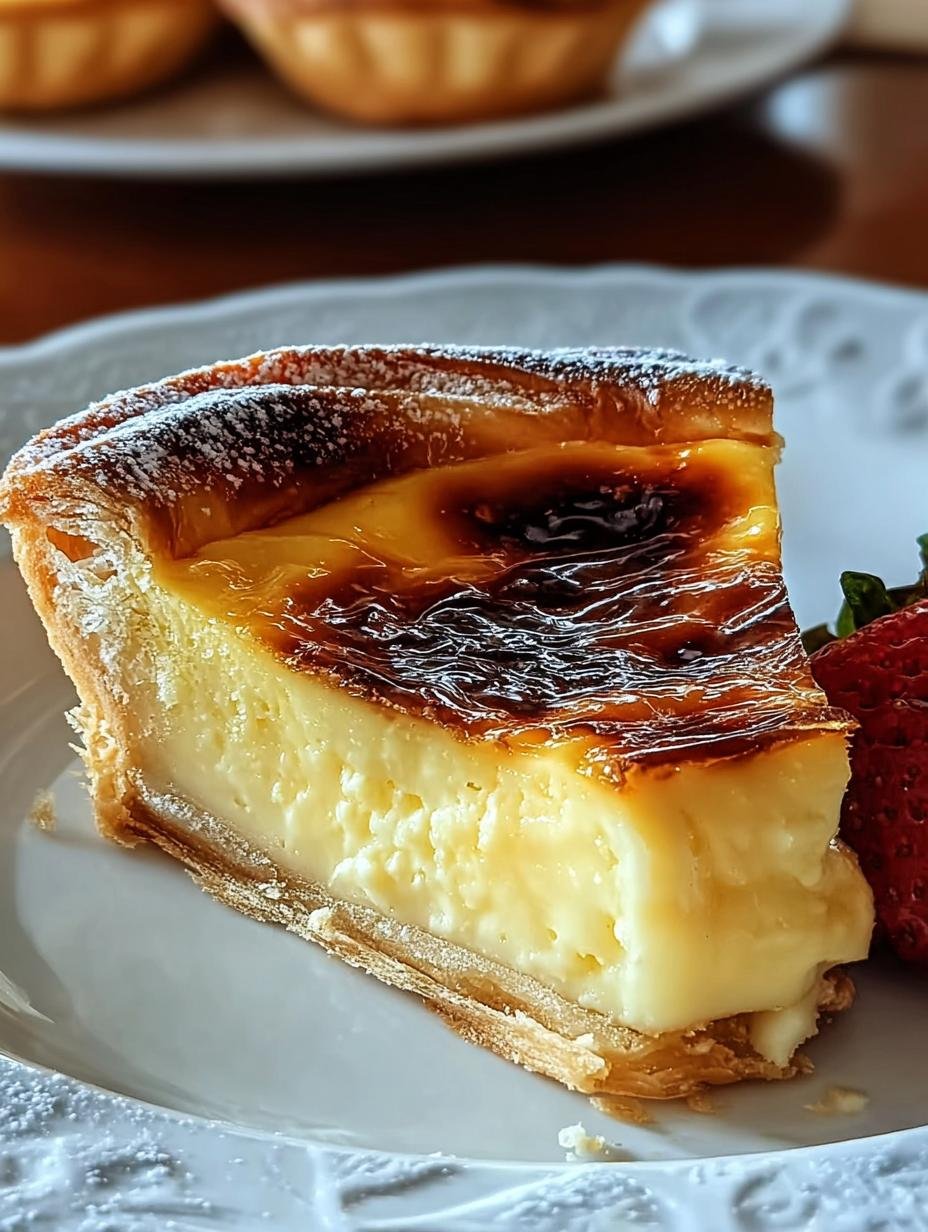Portuguese custard tart has been my obsession ever since I first tasted one on a trip to Lisbon. The delicate crunch of the flaky pastry giving way to a warm, unbelievably creamy custard filling, slightly caramelized on top with a hint of cinnamon – it’s pure magic! I remember walking down a cobblestone street, the sweet aroma filling the air, and biting into my first Pastéis de Nata. It was love at first bite! Now, I’ve perfected my own version, aiming for that same authentic bakery bliss, and I can’t wait to share this simple peach pie recipe—wait, no, that’s not right! I mean this authentic Portuguese custard tart recipe with you. Let’s get cooking!
You’re going to adore making these Portuguese Custard Tarts, even if you’ve never baked a thing before! They’re surprisingly straightforward and incredibly rewarding.
- Authentic Flavor: Get that true taste of Lisbon right in your own kitchen.
- Crispy, Flaky Pastry: Each bite offers a delightful crunch that’s so satisfying.
- Silky Smooth Custard: The rich, creamy filling is pure indulgence.
- Beautifully Caramelized Tops: That slightly burnt sugar finish is a sign of perfection.
- Impress Your Guests: These look and taste like they came from a fancy bakery.
- Perfect for Any Occasion: Serve them for breakfast, dessert, or with your afternoon coffee. They make a simple peach pie dessert look boring!
- Relatively Quick: You can whip up this delicious homemade peach pie dessert in under an hour total time.
- So Much Better Than Store-Bought: Nothing beats the fresh-baked taste of homemade.
Ingredients for Portuguese Custard Tart
Making these authentic Portuguese Custard Tarts is easier than you might think, and using the right ingredients makes all the difference! It’s a delightful process, almost as satisfying as making a delicious homemade peach pie from scratch.
- 1 sheet (about 250 g) puff pastry – thawed if frozen, this is key for that signature flaky texture
- 1 cup (240 ml) whole milk – provides richness to the custard
- 1 tablespoon (8 g) all-purpose flour – acts as a thickener for our silky custard
- ¾ cup (150 g) granulated sugar – for sweetness in the custard and the caramelized topping
- ⅓ cup (80 ml) water – combined with sugar to create a simple syrup
- 1 cinnamon stick – infuses a warm, aromatic flavor into the syrup
- 1 strip lemon peel (optional) – adds a subtle brightness to cut through the richness
- 6 large egg yolks – the secret to the incredibly creamy and rich custard
- 1 teaspoon pure vanilla extract – enhances all the other flavors
- A pinch of salt – balances the sweetness
- Ground cinnamon (for topping) – a classic finishing touch
- Powdered sugar (for topping) – for a final dusting of sweetness
How to Make Portuguese Custard Tart
Get ready to create some magic! Making these beautiful Portuguese Custard Tarts is a journey that fills your kitchen with incredible aromas and leads to a truly spectacular dessert. It’s a process that rivals even the most beloved homemade peach pie recipe.
- Step 1: Prepare the pastry. Preheat your oven to a scorching 475°F (245°C). This high heat is crucial for that perfect, crisp puff pastry. On a lightly floured surface, roll out your thawed puff pastry sheet just a little more. Tightly roll it into a log, then slice it into 12 equal pieces. Press each slice, cut-side down, into a greased muffin tin. Use your thumbs to gently press and shape the dough into a tart shell, coming up the sides. Pop these into the fridge to chill while you make the filling – this prevents them from shrinking too much.
- Step 2: Make the sugar syrup. In a medium saucepan, combine the ¾ cup (150 g) granulated sugar, ⅓ cup (80 ml) water, the cinnamon stick, and the optional lemon peel. Bring this to a boil over medium-high heat and let it bubble away for about 3-4 minutes, until it thickens slightly. You’re looking for a light syrup consistency. Once it’s ready, remove the pan from the heat.
- Step 3: Prepare the milk mixture. In a separate small bowl, whisk the 1 tablespoon (8 g) all-purpose flour with a tiny splash of the 1 cup (240 ml) whole milk until you have a smooth paste. Pour in the rest of the milk and whisk again. Cook this mixture in a saucepan over medium heat, whisking constantly, until it just begins to thicken. Don’t let it boil. Remove from heat.
- Step 4: Combine the custard. Fish out the cinnamon stick and lemon peel from your sugar syrup. Now, very slowly and carefully, pour the hot syrup into the thickened milk mixture while whisking vigorously. You want to temper the milk so it doesn’t scramble. In a separate bowl, whisk your 6 large egg yolks, then gradually temper them by slowly drizzling in about half of the warm milk-syrup mixture while whisking constantly. Once tempered, pour the egg yolk mixture back into the saucepan with the rest of the milk mixture. Stir in the 1 teaspoon pure vanilla extract and the pinch of salt. For the silkiest texture, strain this custard through a fine-mesh sieve into a bowl.

- Step 5: Fill and bake. Retrieve your chilled pastry shells from the fridge. Carefully fill each one with the strained custard mixture, leaving about ¼ inch of space at the top. You want them full, but not overflowing.
- Step 6: Bake to perfection. Place the muffin tin into your preheated hot oven. Bake for just 12-15 minutes. Keep a close eye on them! You’re looking for the custard to puff up, bubble, and develop those beautiful, dark, caramelized spots on top. The pastry should be a deep golden brown and wonderfully crisp.
- Step 7: Cool and serve. Let the tarts sit in the muffin tin for about 5 minutes to firm up slightly. Then, carefully remove them and place them on a wire rack to cool. For the most authentic experience, serve them warm, dusted generously with ground cinnamon and a little powdered sugar. They are an exquisite simple peach pie dessert alternative!
Pro Tips for the Best Portuguese Custard Tart
I’ve learned a few tricks over the years that really elevate these tarts from good to absolutely divine. Following these simple tips will help you achieve that bakery-quality result at home, making your homemade peach pie recipe seem like a distant memory!
- Always use store-bought puff pastry for ease and consistent flakiness. Trying to make puff pastry from scratch is a whole other ballgame!
- Don’t skip chilling the pastry shells before filling; this is key to preventing shrinkage and ensuring a crisp base.
- A very hot oven is your best friend for achieving those characteristic caramelized spots and crispy pastry.
- Strain your custard mixture through a fine-mesh sieve for an ultra-smooth, luxurious texture.
- Serve them warm for the most authentic experience – the contrast of warm custard and crisp pastry is perfection.

What’s the secret to perfect Portuguese Custard Tart?
The secret lies in the incredibly hot oven, which creates those signature dark, caramelized spots on the custard and ensures the puff pastry bakes up shatteringly crisp. It mimics the traditional baking method perfectly. For more on baking science, check out this guide to understanding ingredients.
Can I make Portuguese Custard Tart ahead of time?
You can prepare the custard filling a day in advance and store it covered in the refrigerator. However, it’s best to bake the tarts just before serving for optimal pastry crispness.
How do I avoid common mistakes with Portuguese Custard Tart?
Avoid overmixing the custard, which can make it tough. Also, resist the urge to open the oven door too early; this can cause the pastry to deflate. Finally, ensure your oven is truly at the correct high temperature.
Best Ways to Serve Portuguese Custard Tart
These delightful Portuguese Custard Tarts are incredibly versatile and can be enjoyed in so many ways. They are a fantastic alternative to a simple peach pie dessert, offering a unique sweet and creamy experience. For an authentic Portuguese treat, serve them slightly warm, dusted with a little powdered sugar and a sprinkle of cinnamon. This highlights the contrast between the warm, luscious custard and the crisp, flaky pastry.
They pair wonderfully with a strong cup of coffee or a rich espresso, much like how a classic peach pie might be enjoyed with iced tea. If you’re feeling adventurous, try them alongside a scoop of vanilla bean ice cream for a decadent dessert. They are truly a delicious homemade peach pie alternative that’s elegant yet easy!
Nutrition Facts for Portuguese Custard Tart
These numbers offer a glimpse into the deliciousness of each individual Portuguese Custard Tart. They’re a treat that balances sweetness and richness beautifully, and are quite comparable to enjoying a slice of a simple peach pie dessert, though with a distinctly Portuguese flair.
- Serving Size: 1 tart
- Calories: 210
- Fat: 10 g
- Saturated Fat: 6 g
- Protein: 4 g
- Carbohydrates: 25 g
- Fiber: 0 g
- Sugar: 15 g
- Sodium: 45 mg
Nutritional values are estimates and may vary based on specific ingredients used and portion sizes.
How to Store and Reheat Portuguese Custard Tart
Properly storing your delicious homemade Portuguese Custard Tarts is key to enjoying them at their best. After baking, let the tarts cool completely on a wire rack. This prevents any residual steam from making the pastry soggy. Once cool, you can store them in an airtight container. For short-term storage, they’ll keep well in the refrigerator for about 3-4 days. They’re still tasty, but the pastry might soften a bit, much like how an old-fashioned peach pie can lose some crispness.
If you want to keep these sweet treats for longer, they freeze beautifully! Place them in a single layer on a baking sheet and freeze until solid, then transfer them to a freezer-safe bag or container. They can be stored in the freezer for up to 3 months. To reheat, simply place them on a baking sheet and warm them in a 300°F (150°C) oven for about 5-8 minutes, or until the pastry is crisp again and the custard is warmed through. This method revives their fresh-baked glory!
Frequently Asked Questions About Portuguese Custard Tart
Can I make the custard for Portuguese Custard Tart ahead of time?
Yes, you absolutely can! I often make the custard base a day in advance and store it covered in the fridge. This is a great time-saver, similar to how you might get a head start on your best peach pie from scratch. Just remember to give it a good whisk before filling your tart shells.
What is the difference between a Portuguese Custard Tart and a regular custard tart?
The main differences lie in the pastry and the custard preparation. Traditional Portuguese Custard Tarts use a puff pastry and a very hot oven to achieve caramelized tops, which is distinct from a typical shortcrust custard tart. The custard itself is also often richer and sometimes made with a sugar syrup, giving it a unique texture and sweetness, unlike many other simple peach pie dessert recipes.
Why are my Portuguese Custard Tarts not browning on top?
This usually happens if your oven isn’t hot enough. For those signature dark, caramelized spots, you need a blazing hot oven, around 475°F (245°C). If your oven struggles to reach that temperature, you might not get the classic look. Ensure your oven is fully preheated and consider using a metal muffin tin, which conducts heat better for that rustic peach pie aesthetic.
Can I substitute the puff pastry for something else?
While puff pastry is traditional, you could experiment with other pastry types if you like. A shortcrust pastry would work, though it won’t give you the same flaky texture. Some people even try a graham cracker crust for a different twist, though it deviates quite a bit from the classic Pastéis de Nata experience, much like a gluten-free peach pie might change the texture.
Variations of Portuguese Custard Tart You Can Try
While the classic Pastéis de Nata is divine, don’t be afraid to get creative! Exploring variations can be just as exciting as trying out a new homemade peach pie recipe for the first time. Whether you’re catering to dietary needs or just looking for a new flavor profile, there are some wonderful twists on this beloved dessert.
- Vegan Portuguese Custard Tart: For a completely plant-based version, you can use a vegan puff pastry and a custard made with plant-based milk (like almond or soy) thickened with cornstarch or silken tofu. These vegan peach pie recipe alternatives are surprisingly creamy and delicious.
- Gluten-Free Portuguese Custard Tart: If gluten is a concern, you can find or make a gluten-free puff pastry. The custard filling itself is naturally gluten-free, making this a fantastic option. It’s a wonderful way to enjoy the flavors without the gluten, much like a gluten-free peach pie variation.
- Flavored Custard: While classic is best, you can infuse subtle flavors into the custard. Consider adding a bit of orange zest along with the lemon peel, or a hint of cardamom for a different aromatic note. This is a fun way to experiment, similar to adding spices to your summer peach pie filling.
- Mini Tarts: For bite-sized treats perfect for parties, simply use mini muffin tins or tartlet molds. They bake faster and are incredibly cute, offering a delightful little bite of sweetness.

Portuguese Custard Tart: 7 Steps to Magic
- Total Time: 35 minutes
- Yield: 12 tarts 1x
- Diet: Vegetarian
Description
Irresistibly creamy and flaky Portuguese Custard Tarts, also known as Pastéis de Nata, are a beloved pastry from Portugal. This recipe delivers authentic bakery flavor with a crisp puff pastry shell and a silky, caramelized custard filling, perfect for any occasion.
Ingredients
- 1 sheet (about 250 g) puff pastry, thawed if frozen
- 1 cup (240 ml) whole milk
- 1 tablespoon (8 g) all-purpose flour
- ¾ cup (150 g) granulated sugar
- ⅓ cup (80 ml) water
- 1 cinnamon stick
- 1 strip lemon peel (optional)
- 6 large egg yolks
- 1 teaspoon pure vanilla extract
- A pinch of salt
- Ground cinnamon (for topping)
- Powdered sugar (for topping)
Instructions
- Prepare the pastry: Roll out the puff pastry sheet. Tightly roll it into a log, then cut into 12 slices. Place each slice cut-side down into a greased muffin tin and shape into a shell using your thumbs. Chill the shells.
- Make the sugar syrup: Combine sugar, water, cinnamon stick, and lemon peel in a saucepan. Boil for 3-4 minutes until slightly thickened. Remove from heat.
- Prepare the milk mixture: Whisk flour with a little milk until smooth, then add the remaining milk. Cook over medium heat, whisking, until slightly thickened. Remove from heat.
- Combine the custard: Remove cinnamon stick and lemon peel from the syrup. Slowly pour the syrup into the milk mixture while whisking. In a separate bowl, whisk egg yolks, then gradually add them to the warm mixture. Stir in vanilla extract and salt. Strain the custard through a fine sieve.
- Preheat and fill: Preheat your oven to 475°F (245°C). Fill each chilled pastry shell with custard, leaving some space at the top.
- Bake: Bake for 12-15 minutes, or until the tops are bubbling and caramelized, and the pastry is deep golden brown.
- Cool and serve: Let the tarts cool in the pan for 5 minutes, then transfer to a cooling rack. Serve warm, dusted with powdered sugar and cinnamon.
Notes
- Use a very hot oven to ensure the puff pastry crisps beautifully.
- Chill the pastry shells before filling to prevent shrinking.
- Strain the custard through a sieve for an ultra-smooth texture.
- Metal muffin tins conduct heat better for crispier edges.
- Serve warm for the best authentic flavor and texture.
- Prep Time: 20 minutes
- Cook Time: 15 minutes
- Category: Dessert, Pastry
- Method: Baked
- Cuisine: Portuguese
Nutrition
- Serving Size: 1 tart
- Calories: 210
- Sugar: 15 g
- Fat: 10 g
- Carbohydrates: 25 g
- Fiber: 0 g
- Protein: 4 g

